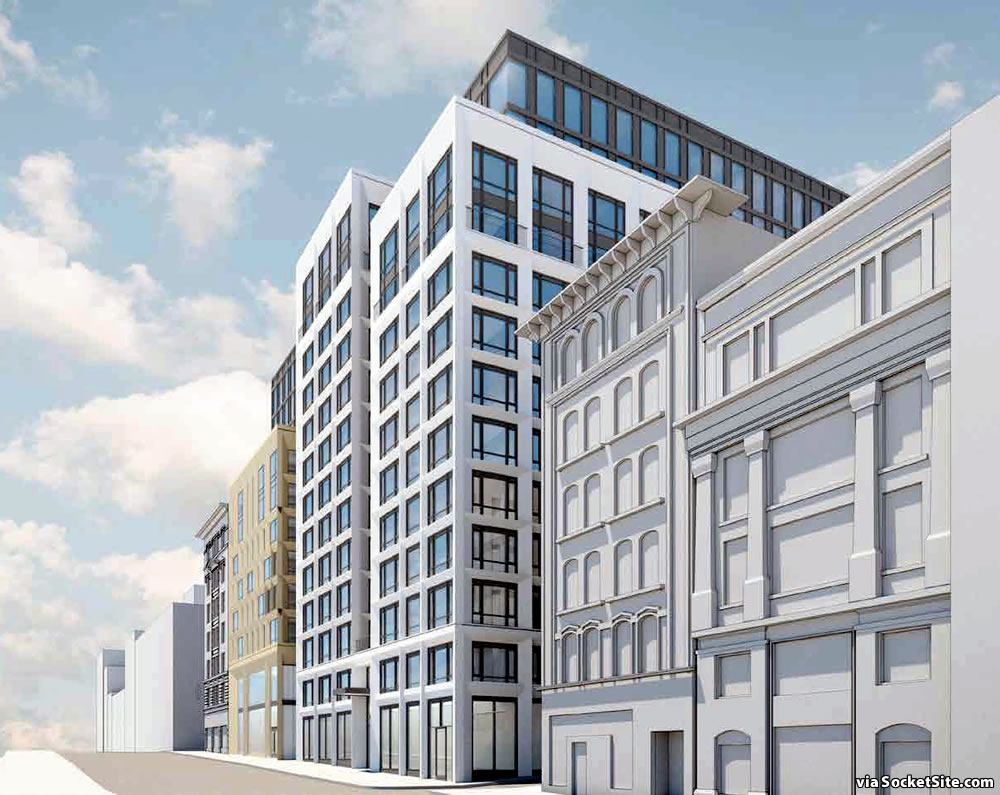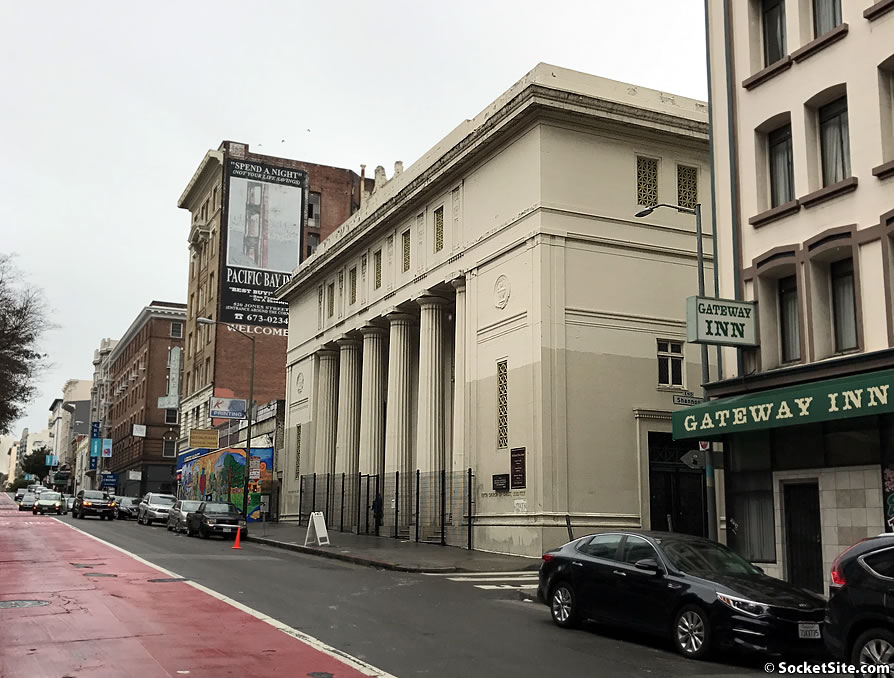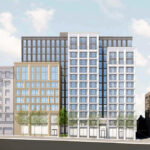As we first reported earlier this year, a proposed revision to the previously approved plans for a new 13-story, mixed-use building to rise on the site of the columned Fifth Church of Christ, Scientist at 450 O’Farrell Street was in the works, a revision which would yield around 300 units of “Group Housing,” “well suited [for] workforce housing,” rather than 176 individual apartments.
The impact report for the development has just been amended to reflect the proposed change, demolition permits have been requested, and the building’s design has since been refined, as newly rendered by Gensler for Forge Development Partners:
And we’ll note, while the revised project does increase the number of dwelling units on the site from 176 to 302 as proposed, the group housing approach is actually projected to accommodate fewer total residents and population growth, with the 176 apartments having been projected to provide housing for around 405 residents versus 316 residents in the 302 units of group housing.




Wonderful project
This is not a wonderful project from any perspective except that of those who have an equity interest in “Forge Development Partners”. Group housing, especially in the age of virus-borne pandemics, are not well-suited for workforce housing, but it is very well suited to lining the pockets of the greedheads who own development companies.
if and when the development gets completed, of course, it will get leased out promptly. And the principals of “Forge Development Partners” will be laughing about it all the way up the back nine.
Topically, I will never understand the visceral hatred people have for non-traditional unit types. It’s okay that some people would be happy to live in a group housing arrangement like that, and disliking it personally is not at all a good reason to prevent different types of housing from being added to the mix.
As an aside, you can’t really call this the “age of virus-borne pandemics” when you’re only talking about one thing. An “age” usually requires a *very* long single event or more commonly a long period or series of multiple parallel or overlapping events that are similar in some respect.
“It’s okay that some people would be happy to live in a group housing arrangement like that”
People may TOLERATE living like that, but very few people would be HAPPY living like that. You are confusing an acceptable living condition of the workforce caused by downward economic realities with “demand.” There is very little “demand” for group housing. Same goes for micro-units. People don’t desire dormitory living or living in cramped quarters. They simply accept it because its all they can afford.
There isn’t zero demand though. And the fact that almost none of this gets built still means we’re not building enough to meet demand, whether that demand is based on actual preference or simply acceptability.
I would love to live in a 12 bedroom mansion in the Castro, and relative to that future, my current rental is a miserable shack. Either is better than commuting hours to my job, though (Muni meltdowns notwithstanding).
If anything, the rapid success of the mRNA vaccine suggests we may be at the end of the “age of virus-borne pandemics.” We had a vaccine at the end of January of 2021!
Globalization. Overpopulation. We may very well be entering a “age of virus-borne pandemics”.
We might be able to respond quickly with new mRNA vaccines to all of them, but, we still need other effective public sanitation measures to protect people before the vaccines are online.
The history of big cities growing has always been about better sewers, cleaner water supply, more garbage pick up, new ventilation systems, etc enabling that growth.
It’s fair to ask what systems is this developer incorporating to address crowded conditions.
This developer is building a building, which will result in higher taxes, which will pay for better sewers, water, garbage, and so on. These things are paid by taxes and taxes are paid by people living in buildings.
Yes, the developer is proposing to build a building which will result in marginally higher tax receipts, but if they proposed a building with studios, it would also result in higher tax receipts, so what you’re saying is in no way a justification for the group housing, which would produce more people living in much closer proximity.
First of all, it looks like the tax receipts will be significantly larger than they are today.
Is group housing more dangerous than studios? If so, should we ban all SROs?
A friend who moved here from Manhattan commented to me that SF needs more cheap options, like in Manhattan. Manhattan has some shoe-box type places that fit the budget and lifestyle of some people who aren’t home much and don’t cook much. SF doesn’t have many of these.
We need housing diversity for all budgets and lifestyles. This is a great addition and we need way more of these. We also need more of the next tier up, something like a ~200 square foot studio.
What do you think those 4000 units of SRO housing are?
What? You don’t want to live around people who are not as well off or mentally sharp as you and who use different drugs?
There’s a difference between market-rate efficiency housing and below market rate, subsidized, legislatively protected supportive housing. SF only has the latter.
San Francisco historically has several housing typologies. Traditional studios/efficiencies have not been prevalent amongst them. What you say “we” want or need is irrelevant to the fact that SROs serve that function in this built environment.
But, yeah, SF housing policy should be determined by what your friend who moved here from Manhattan thinks.
Well said.
Marcos, what are you even trying to say? SROs are hotels with a mix of transitory and permanent occupants. The City Council specifically treats them as a resource for at-risk populations.
This project proposes a rental building of market-priced efficiency units. Presumably the target market is new arrivals with few possessions and a steady income stream. SROs do not serve this market.
And in the future, please pay attention to whom you’re replying.
Consider 77 Bluxome street – 102 units at market rate. Cubix and 750 Harrison also come to mine as a few examples.
Well, YES to that last question. Absolutely.
I am not sure why you see “greed” in every single project/development…
If the project sponsors were proposing normal studios, or even high efficiency units, I wouldn’t have said anything and I would have cheered them on. But they aren’t. The are proposing group housing, with shared living spaces.
Aren’t high efficiency units exactly what is being proposed?
Unless modified by local ordinance pursuant to Health and Safety Code Section 17958.1, efficiency dwelling units shall comply with the following:
We have people chopping up 6 bedroom Victorians into dormitories, and people are willing to rent them. Why the hell shouldn’t we build new shared housing?
Can you elaborate on how SRO style housing is “well suited to lining the pockets of development companies”? Generally speaking this type of housing has had far lower returns compared to housing people want to live in.
I used to think that smaller units would be a better economic deal. But it turns out that market rate SROs go for a higher PSF than regular apartments. More money for the bare necessities seems neither necessary nor desirable.
Modern market-rate Single Room Occupancy apartments tend to cost more to develop, on a per-square-foot basis, than larger apartments. That doesn’t mean they are more profitable to build. And unfortunately, some of the high cost of these modest apartments is due to local governments assessing fees in ways that are unfair and environmentally damaging.
One reason small apartments often cost more to develop, on a per square foot basis, than large apartments, is that they often have more plumbing and electrical fixtures per square foot. For example, an SRO may have the basically the same plumbing fixtures as a large studio apartment: a kitchen sink, a shower, bathroom sink, and toilet. The cost of those fixtures gets distributed over a smaller apartment size, leading to a higher cost per square foot for plumbing.
Many local governments assess some development impact fees on a per-unit basis. These fees, which help pay for parks, roads, and other municipal services, can be many thousands of dollars per apartment. For example, in Roseville and Oakland, a tiny SRO apartment has to pay the same transportation impact fee as a multi-million-dollar 5000 square-foot penthouse condo. That makes little sense, since renters of tiny apartments usually have a smaller household size and far fewer cars than people who live in large penthouse apartments, drive less, and thus impose fewer impacts on public streets.
This practice of assessing development impact fees on a per-unit basis has several damaging consequences. They include:
1. Developers pay these development impact fees at first, but they pass along on much of the cost to renters in the form of higher rents. Making people who can only afford a small apartment pay the same impact fees as people who live in luxury penthouses is unfair. It imposes a higher burden on folks who (a) on average, impose less burden on municipal facilities like roads, and (b) have less income. That’s backwards.
2. Assessing development impact fees on a per-unit basis results in developers building fewer, larger apartments on a site. This lets them reduce the burden of fees on the project, while still staying within the height and bulk limits imposed by zoning. As a result, cities get fewer homes. Those that do get built are larger, more luxurious, and more expensive.
3. Imposing fees on a per-unit basis incentivizes people to rent or buy larger homes (since the per-square-foot cost of the fee diminishes as home size grows). Building, heating, and maintaining larger homes results in greater environmental damage.
In short, in many cities, the high cost per square foot of smaller apartments is in part due to local government fees that are structured in ways that increase social inequality, hurt the poor, and damage the environment. While performing this at the local level is possible, doing so on a city-by city basis would take many years. What we really need, I think, is state legislation to reform America’s impact fees, which often work at cross purposes to our state’s stated goals.
Good thing that the costs of construction have no bearing on price which is determined by what the market will bear.
No matter what fee scheme the City goes with, developers will try to game it to their advantage. Replacing fees by unit with fees by other metric means trading off one set of costs/benefits with another that developers will likewise game. And fees are set so pathetically low that only those fly-by-night developers pursuing their get-rich-quick scheme would see their marginal projects effected.
This is a good argument for not enabling marginal projects and setting the take such that half of crap projects just don’t pencil out. That way, what we do end up with is the better of the best.
The plumbing you cite as belonging to the average SRO indicates you haven’t been in one. A sink, for both brushing your teeth and your plates is often all that is included. Not all, but the sink sink shower toilet model you cite is non-existent, and I’ve been in a LOT of SRO rooms here in SF.
Precisely but you’re not thinking beyond your own needs. These will work well in locations like south beach and transbay terminal. Short term temporary people love this stuff and turnover costs are cheap as hell. You can realize savings on lots of expenses due and create opportunities for ancillary growth with value add services like 2nd kitchen, smart technology features, and convenient laundry, entertainment, and shared space rentals.
If you look at the plans, the project is basically 302 very efficient individual studio units — actually an ideal housing typology in the “Age of Covid”.
With shared living and open spaces beyond the livable square footage of each unit (which average 281 square feet) and sans ovens in the units (which Group Housing units can’t include).
How come that 2919 Mission gets to be historic, but 450 O’Farrell doesn’t?
Note: this is not an anti-housing rant, but rather an anti capricious actions by the Historic Preservation Commission rant.
While the Instituto Familiar de la Raza at 2919 Mission Street has been added to the City’s Legacy Business Registry, the building itself has actually been deemed ineligible for registration as an historic resource.
I preferred the previous iteration of the design, where the white section of the facade was one unbroken element. Now it has been split in two and one half is taller than the other, so that instead of appearing to be two buildings the design has the appearance of three buildings. Is that really better? Does that really honor the more formal and classical design language of the Tenderloin and the building this project is replacing?
Agreed. But we should be aware that that version of the design looks like it would end up getting heavily value engineered during permitting.
You gotta love the phony terminology. “Group housing” indeed.
It’s a barracks.
Case point example as to why San Francisco’s housing problems will never be resolved – even in the most dense and central parcels of the city is development only 13 floors.
My previous apartment building was on a similar sized lot, had 900 units and was 76 floors (it also had a public school on floors 1-5 and a public park) A building of that type would easily pay for 300 individual affordable units.
But if we built up downtown SF with those sorts of buildings, it would be bad news for existing property owners.
How? It would increase their value. The value of the land is capped by the zoning/density limits. Increase that and values will go up in parallel. I would argue that it would make sense for the city to capture some of that value to rather than let it all go to landowners but that’s a separate discussion.
Sorry, I meant people who own homes in the rest of the city. It would definitely be great news for the owners of the property which was up zoned. Snide comment was that one outcome of underbidding housing is that existing homeowners have seen their properties skyrocket in value over the last 30 years.
Yeah but you aren’t considering the geography of SF and level of demand or appetite for this type of deal in SF. Right now there are 400 unit deals that are struggling to stay in the 80% occupancy range even with 3 month concessions.
How would a 900 unit behemoth deal even fill up anytime soon? Your money is better off in another investment for now.
What the moralizing against group housing misses (other than the obvious, “just because you wouldn’t live there doesn’t mean it’s bad”) is that it’s a strict improvement over sharing a family apartment with roommates who aren’t your friends, which is realistically what a lot of young people in San Francisco are doing already.
I’m fairly confident most young people would prefer to have 2-3 roomates (or possibly more) sharing 1-2 bathrooms and a kitchen/living space than a barracks where you have 15+ roomates per floor. At least in the former scenario you know everyone’s name. I don’t see how this is a strict improvement.
There’s a certain feeling of security that comes with having a bedroom door that locks.
To say nothing of worrying if a roommate won’t pay their share of rent, hunting for a replacement when they move out…
As the other reply to me points out, these group housing situations often command higher rent than ad-hoc rooming with random people off Craigslist. That’s because people prefer the experience.
If you still don’t see it, all I’ll say is I’m happy for your good luck in roommates.
What the “tsk tsk-ing” in favor of group housing like this proposal by commenters pimping for the developer misses is that in sharing a family apartment with roommates who aren’t your friends, which a lot of young people in San Francisco are doing already, roommates are almost always paying less than the otherwise-available rate for their rooming arrangement, such as it is.
With this proposal, the developer, or ultimate owner of the building will be collecting that savings because the tenants will wind up paying more on an equivalent basis, than those sharing an apartment with roommates.
UPDATE: Supervisors Overturn Approval of Group Housing “Switcheroo”